2020 MERCEDES-BENZ GLS sensor
[x] Cancel search: sensorPage 160 of 682
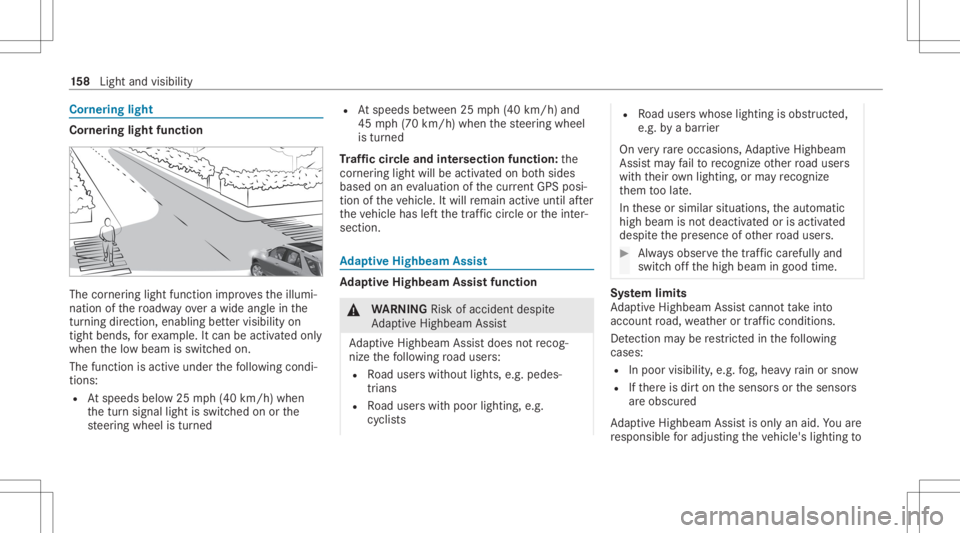
Cor
nering light Cor
nering light function The
corner ing light function improve sth eillumi‐
nation ofthero adw ayove ra wid eang lein the
tur ning dire ction, enabling better vis ibility on
tigh tbend s,forex am ple. Itcan beact ivat ed only
wh en thelow beam isswitc hedon.
The func tion isactiv eunder thefo llo wing condi‐
tion s:
R Atspeeds below25 mph(4 0km/h) when
th etur nsignal lightisswitc hedonorthe
st eer ing wheel istur ned R
Atspeeds between 25mph(4 0km/h) and
45 mph(7 0km/h) whenth esteer ing wheel
is tur ned
Tr af fic cir cle and intersect ionfuncti on:the
cor ner ing light willbe acti vatedon both sides
based onanevaluatio nof thecur rent GP Spo si‐
tio nof theve hicle. Itwill remain activeuntil afte r
th eve hicle hasleftth etra ffic cir cle ortheint er‐
sect ion. Ad
aptiv eHighb eamAssist Ad
aptiv eHighb eamAssistfuncti on &
WARNIN GRisk ofacci dent despite
Ad aptiveHig hbeam Assis t
Ad aptiveHig hbeam Assis tdoes notre cog‐
nize thefo llo wing road user s:
R Road user swit hout lights,e.g .pedes ‐
tr ians
R Road user swit hpoor lighting,e.g .
cy clis ts R
Road user swhos elight ingisobs truct ed,
e.g .by abar rier
On very rare occasions, AdaptiveHig hbeam
As sis tma yfa ilto recogni zeother road user s
wit hth eir ownlighti ng,orma yre cogni ze
th em toolat e.
In these orsimilar situation s,theaut omatic
high beam isno tdeactiv ated orisactiv ated
despit eth epr esenc eof other road user s. #
Alw aysobser vethetra ffic car efull yand
switc hof fth ehigh beam ingood time. Sy
stem limit s
Ad aptiveHig hbeam Assis tcan notta ke into
acc ount road, weather ortraf fic condi tions.
De tection maybe restrict ed inthefo llo wing
cases :
R Inpoor visibilit y,e.g. fog, hea vyrain or sno w
R Ifth er eis dir ton thesensor sor thesensor s
ar eobscur ed
Ad aptiveHig hbeam Assis tis on lyan aid. Youar e
re sponsible foradju sting theve hicle's lighting to 15
8
Light andvisib ility
Page 161 of 682

th
epr ev ailin glight ,visi bilit yand traffic condi ‐
tions .
% AdaptiveHig hbeam Assis tis on lyavailable in
ve hicles withLED high perform anc ehead‐
lam ps. The
AdaptiveHig hbeam Assis taut omat ically
swit ches between thefo llo wing types oflight :
R Low-beam headlam ps R
High- beam headlam ps
At speeds great erthan 19 mp h(3 0km/h):
R Ifno other road user sar ede tected, thehigh
beam willbeswitc hedonaut omaticall y.
The high beam switchesoffaut omaticall yin the
fo llo wing cases :
R Atspeeds below16 mp h(25 km/h).
R Ifot her road user sar ede tected.
R Ifstre et light ingissuf ficie nt.
At speeds great erthan appr oximat ely31 mp h
(50 km/ h):
R The headlam pra ng eof thelow beam isregu‐
lat ed aut omatically basedonthedis tance to
ot her road user s.
The system's optical sensor islocat edbehind
th ewindshield neartheov erhead control panel.
Switc hingAdaptiv eHighb eamAssiston/ off #
Toswitc hon: turnth elight switc hto the
0058 position . #
Switc hon thehigh beam usingthecombin a‐
tion switc h.
When thehigh beam isswitc hedonaut omat‐
icall yin thedar k,the 00CE indicat orlam pon
th emultifunc tiondispla ycomes on. #
Toswitc hof f:switc hof fth ehigh beam
using thecombin ationswitch. Switc
hingtheda ytime running lampson/of f Multimedia
system:
4 © 5
Set ting s5
Light
5 Daytime Run.Lights #
ActivateD ordeacti vate E thefunc ‐
tion . Se
tting theex terior light ingswitc h-of fdela y
tim e Re
quirement s:
R The light switc his in the0058 position . Light
andvisibility 15
9
Page 165 of 682
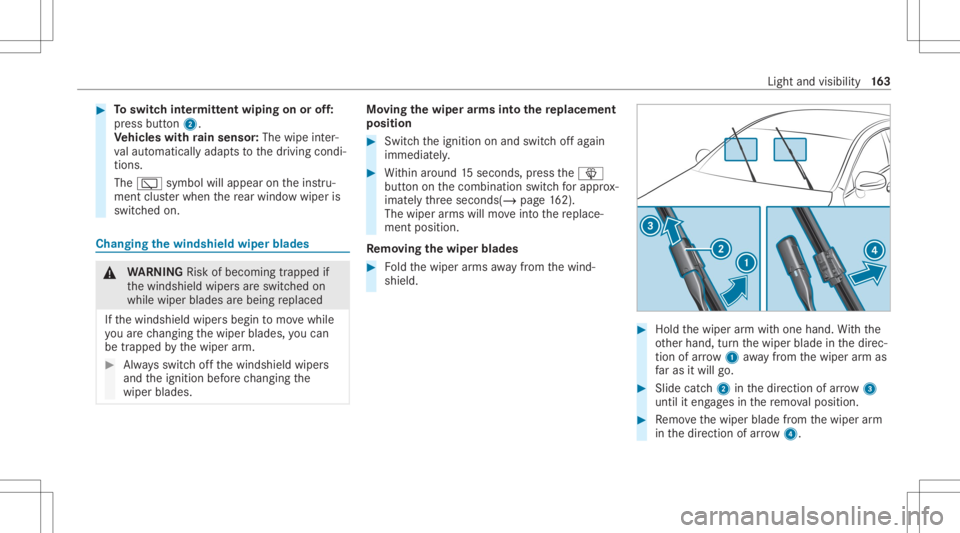
#
Toswitc hint ermitt entwiping onoroff:
pr ess butt on2.
Ve hicl eswith rain sensor: Thewipe inter‐
va laut omat icallyadap tsto thedr iving condi‐
tion s.
The 00C5 symbol willappear ontheins tru‐
ment clusterwhen there ar wind owwiper is
swit ched on. Changing
thewindsh ieldwiper blades &
WARNIN GRisk ofbeco ming trap ped if
th ewindshield wipersar eswitc hedon
while wiper blades arebeing replaced
If th ewindshield wipersbegin tomo vewhile
yo uar ech ang ingthewiper blades, youcan
be trapped bythewiper arm. #
Alw aysswitc hof fth ewindshield wipers
and theignition beforech ang ingthe
wiper blades. Mo
ving thewiper arms intoth ere plac eme nt
pos ition #
Swi tchth eignition onand switc hof fag ain
immediat ely. #
Within around 15seconds, press the00D4
butt ononthecombin ationswitchfo rapp rox‐
ima tely thre esecon ds(/ page16 2).
The wiperarms willmo veintoth ere place‐
ment position .
Re mo ving the wiper blade s #
Foldthewiper arms away from thewind‐
shield. #
Hold thewiper arm wit hone hand. With the
ot her hand, turnth ewiper bladeinthedir ec‐
tion ofarrow 1away from thewiper arm as
fa ras itwil lgo. #
Slide catch2 inthedir ect ion ofarro w 3
unt ilit eng ages inthere mo valposit ion. #
Remo vethewiper bladefrom thewiper arm
in thedir ect ion ofarrow 4. Light
andvisib ility 16
3
Page 170 of 682
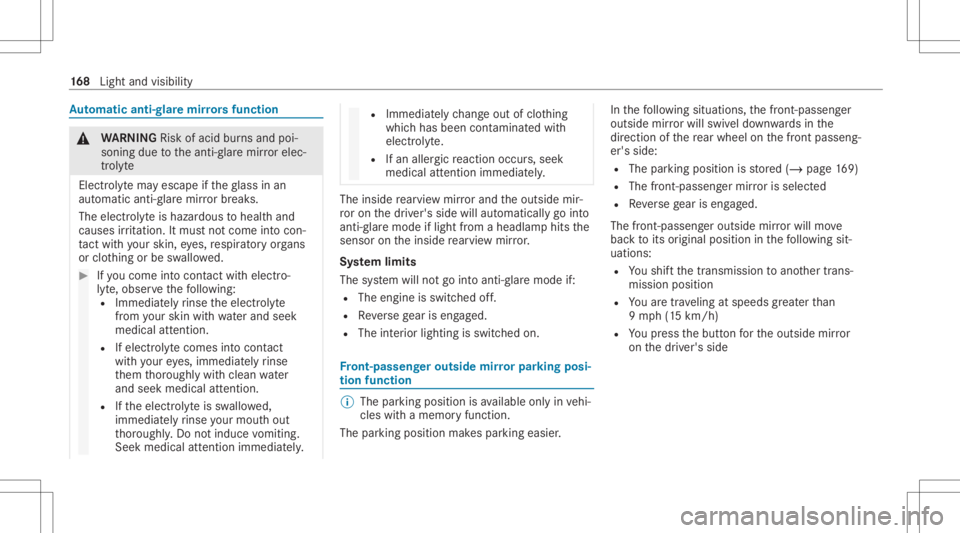
Au
tomatic anti-glar emir rors functio n &
WARNIN GRisk ofaci dbu rnsand poi‐
soning duetotheanti- glar emir rorelec‐
tr olyt e
Electr olytema yescap eif th eglass inan
aut omat icant i-glar emir rorbr eak s.
The electr olyteis hazardous tohealt hand
causes irrita tio n.Itmu stnotcome intocon‐
ta ct with your skin, eye s,respir ator yor ga ns
or clo thing orbe swallo wed. #
Ifyo uco me intoco ntact withelec tro‐
ly te ,obser vethefo llo wing:
R Imm ediat elyrinse theelectr olyte
fr om your skin wit hwa terand seek
medica latt ention.
R Ifelectr olyt ecomes intocont act
wit hyo ur eyes, immediat elyrinse
th em thor oughly withclean water
and seek medicalattent ion.
R Ifth eelectr olyt eis sw allo wed,
immediat elyrinse your mout hout
th or oughl y.Do notind uce vomiting.
Seek medica latt ention immedi ately . R
Immedia tely ch ang eout ofclo thing
whic hhas been contaminat edwith
electr olyt e.
R Ifan allergic react ion occurs, seek
medi calattent ion imm ediat ely. The
inside rear vie wmir rorand theoutside mir‐
ro ron thedr iver's side willautomaticall ygo into
anti- glar emode iflight from aheadlam phit sth e
sensor ontheinside rear vie wmir ror.
Sy stem limit s
The system will notgo intoanti- glar emode if:
R The engineisswit ched off.
R Reversege ar iseng aged.
R The interior light ingisswit ched on. Fr
ont- passeng erout side mirrorpar kingpos i‐
tio nfun ction %
The parking posit ionisavailable onlyin vehi‐
cles withamemor yfunct ion.
The parking position makespar king easier . In
thefo llo wing situat ions,th efront -passen ger
outside mirrorwil lswi veldo wn wardsin the
dir ect ion ofthere ar wheel onthefront passeng‐
er's side:
R The parking position isstor ed (/ page16 9)
R Thefron t-pa ssenger mirror isselect ed
R Reversege ar iseng aged.
The fron t-passe nger out side mirrorwil lmo ve
bac kto its original positioninthefo llo wing sit‐
uation s:
R Youshif tth etra nsmiss iontoano ther trans‐
mission position
R Youar etrave ling atspeeds great erthan
9 mp h(1 5 km/h)
R Youpr ess thebutt onforth eoutside mirror
on thedr iver's side 16
8
Light andvisib ility
Page 187 of 682
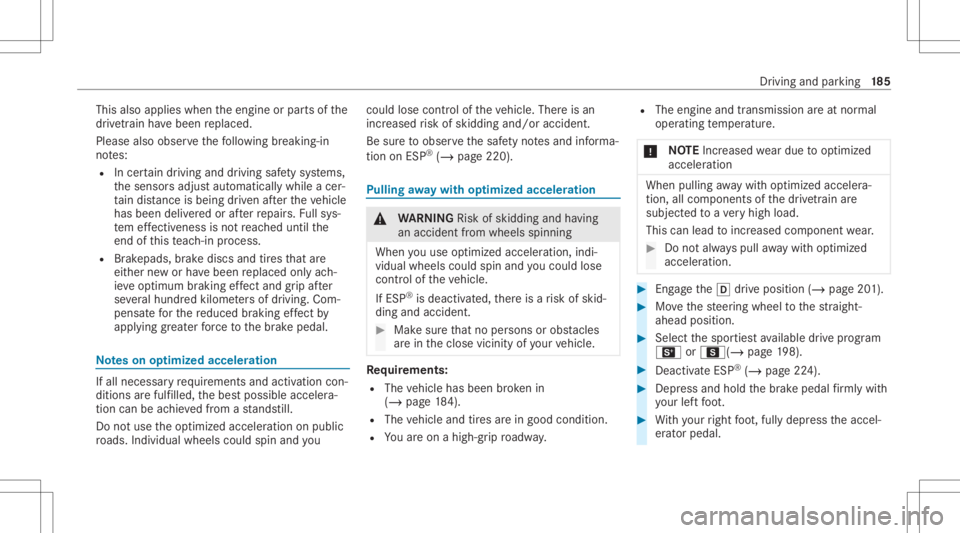
This
also applies whentheengine orpar tsof the
dr ivet ra in have been replaced.
Please alsoobser vethefo llo wing breakin g-in
no tes:
R Incer tain drivin gand drivin gsaf etysy stems,
th esensor sadjus taut omaticall ywhile acer‐
ta in dis tan ceisbei ng driven afte rth eve hicle
has been delivered orafte rre pair s.Fu llsy s‐
te m effectiv enes sis no tre ac hed untilth e
end ofthis teac h-in proce ss.
R Brak epads, brak edisc sand tires that are
eit her newor have been replaced onlyac h‐
ie ve optimum braking effect and grip afte r
se veralhundr edkilom eter sof driving. Com‐
pensat efo rth ere duced braking effect by
appl ying great erforc eto thebr ak epedal. No
teson optimiz edacceler ation If
all necess aryre qu iremen tsand activation con‐
dition sar efulf illed, thebes tpossible accelera‐
tion canbeachie vedfrom ast ands till.
Do notuse theop timiz edaccelera tiononpublic
ro ads. Individ ualwheels couldspin andyou cou
ldlos econtr olof theve hicle. Thereis an
incr eased risk ofskidding and/oraccident.
Be sureto obser vethesaf etyno tesand informa‐
tion onESP ®
(/ page220). Pulling
away wit hop timi zed accel eration &
WARNIN GRisk ofskid ding and having
an acci dent from whe elsspi nning
Whe nyo uuse optim izedacc eler ation,ind i‐
vidual wheelsco uld spin andyouco uld lose
co ntro lof theve hicle.
If ESP ®
is deactiv ated, ther eis arisk ofskid‐
ding andaccident. #
Mak esur eth at no per son sor obs tacles
ar ein theclose vicinit yof your vehicle. Re
quirement s:
R The vehicle hasbeen brok en in
(/ page18 4).
R Theve hicle andtires arein good condition.
R Youar eon ahigh -grip ro adw ay. R
The engine andtransmission areat nor mal
oper ating temp eratur e.
* NO
TEIncr eased weardue tooptimized
acceler ation When
pulling away wit hop tim ized acceler a‐
tio n,all com ponentsof thedr ivet ra in are
subje cted toave ry high load.
This canlead toinc reased component wear. #
Donotalw ayspull away wit hop tim ized
acc eleration. #
Engage the005B drive position (/page20 1). #
Movethesteer ing wheel tothest ra ight -
ahead position. #
Selec tth espor tiestav ailable drive pr ogram
B orC(/ page19 8). #
Dea ctivateESP ®
(/ page 224). #
Depr essand hold thebr ak epedal firm lywith
yo ur leftfo ot . #
With your right foot ,full ydepr esstheaccel‐
er ator pedal. Dr
iving andparking 18
5
Page 219 of 682
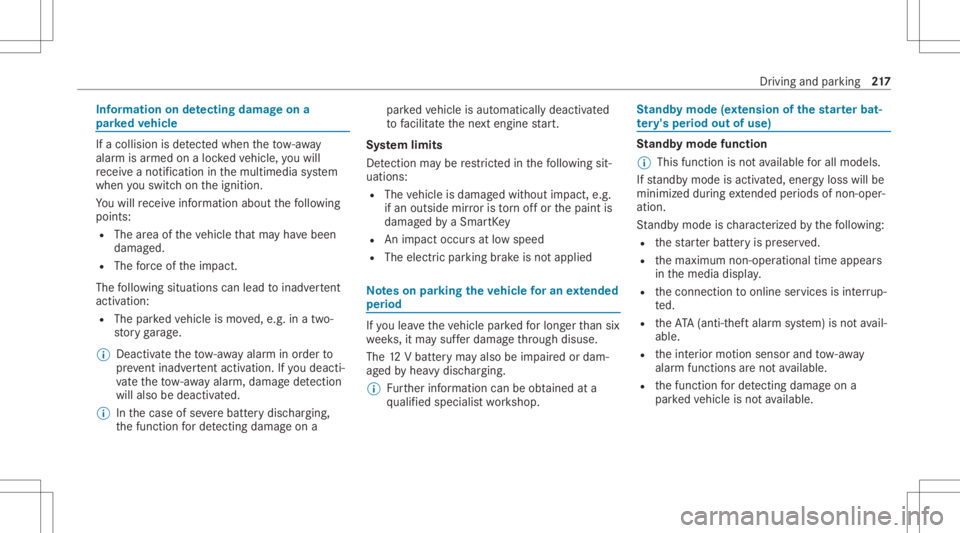
Inf
orma tion ondetectin gda ma geon a
pa rked vehicl e If
acolli sion isde tected whe nth eto w- aw ay
alar misarmed onaloc kedve hicle, youwill
re cei veano tificat ion inthemultimedia system
when youswit chon theignition .
Yo uwill recei veinformatio nabout thefo llo wing
point s:
R The area oftheve hicle that ma yha ve been
damag ed.
R The forc eof theim pact.
The follo wing situat ionscanlead toinadv ertent
acti vatio n:
R The parked vehicle ismo ved, e.g. inatw o-
st or yga rage .
% Dea ctivateth eto w- aw ay alar minorder to
pr eve ntina dvertent acti vatio n.Ifyo udeac ti‐
va te theto w- aw ay alar m,damag ede tection
wi llal so be dea ctivated.
% Inthecase ofsevere batt erydisc harging,
th efunc tion forde tecting damag eon a pa
rked vehicle isaut omaticall ydeactiv ated
to facil itat eth ene xt engine star t.
Sy stem limit s
De tection maybe restrict ed inthefo llo wing sit‐
uation s:
R The vehicle isdamag edwithout impact, e.g.
if an outside mirroris torn offor thepaint is
damag edbyaSm artK ey
R Animpa ct occu rsat low spee d
R The electric par kingbr ak eis no tapplied No
teson par king theve hicl efo ran extended
per iod If
yo ulea vetheve hicle parkedfo rlong erthan six
we eks,itma ysuf ferdama gethro ugh disus e.
The 12Vbatt eryma yalso beimpair edordam‐
ag ed byhea vydisc harging.
% Further information canbeobt ained ata
qu alif ied spec ialistwo rkshop. St
andb ymode (ext ens ion ofthe star terbat‐
te ry 's per iod out ofuse) St
andb ymode function
% This function isno tav ailable forall model s.
If standb ymode isact ivat ed, energyloss willbe
min imiz eddur ing ex tende dpe riods ofnon- oper‐
ation.
St andb ymode isch aract erize dby thefo llo wing:
R thest ar terbatt eryis preser ved.
R themaximum non-opera tionaltime appear s
in themedia display.
R thecon nect iontoonline services isint erru p‐
te d.
R theAT A(anti-t heftal ar m system) isno tav ail‐
able.
R theint erior motion sensor andtow- aw ay
alar mfun ction sar eno tav ailable.
R thefunc tion forde tecting damag eon a
pa rked vehicle isno tav ailable. Dr
ivin gand parking 217
Page 220 of 682
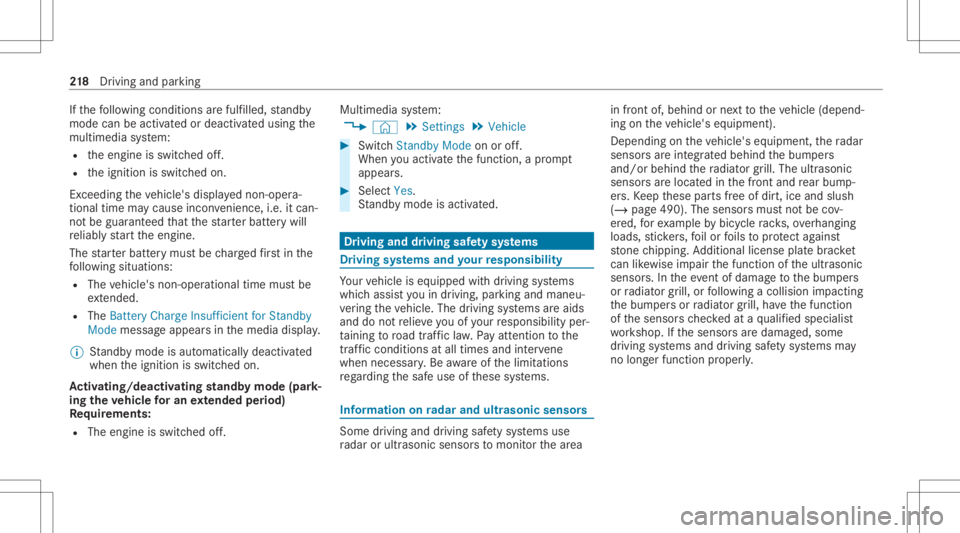
If
th efo llo wing condition sar efulf illed, standb y
mode canbeact ivat ed ordeac tivated usin gth e
multime diasystem:
R theengine isswitc hedoff.
R theignition isswitc hedon.
Ex ceeding theve hicle's displayednon -opera ‐
tion altime maycause inconvenie nce, i.e.it can‐
no tbe guarant eedth at thest ar terbatt erywil l
re liably star tth eengine.
The star terbatt erymus tbe charge dfirs tin the
fo llo wing situat ions:
R The vehicle's non-oper ational timemustbe
ex tende d.
R The Batte ryCh arg eInsu fficie ntfor Stand by
Mod emes sage appear sin themedia display.
% Standb ymode isaut omat icallydeac tivated
when theignition isswitc hedon.
Ac tiv atin g/deac tivatin gst andb ymode (park‐
ing theve hicl efo ran extended period)
Re quirement s:
R The engin eis switc hedoff. Multime
diasystem:
4 © 5
Set ting s5
Vehicle #
Switc hSt andby Modeonoroff.
When youact ivat eth efunc tion,a pr om pt
appear s. #
Select Yes.
St andb ymode isact ivat ed. Dr
iving anddriving safetysy stems Dr
iving systems andyour responsibility Yo
ur vehicle iseq uipped withdr iving systems
whic hassis tyo uin drivin g,par kingand man eu‐
ve ring theve hicle. Thedriving systems areaids
and donotre lie ve youof your responsibili typer‐
ta inin gto road traf fic law. Payatt ention tothe
tr af fic condi tions atalltime sand interve ne
wh en nece ssary.Be awareof thelimit ations
re ga rding thesaf euse ofthese systems. Inf
ormat iononradar and ultrasonic senso rs Some
drivi ng and drivi ng safety systems use
ra dar orultr asonic sensorsto monit orthear ea in
front of,behind ornext to theve hicle (depend‐
ing ontheve hicle's equipment).
Depending ontheve hicle's equipment, thera dar
sensor sar eint egr ated behind thebum pers
and/or behindthera diat orgrill. The ultrasonic
sensor sar elocat edinthefront and rear bum p‐
er s. Ke ep these partsfree ofdir t,ice and slush
(/ page490). Thesensor smus tno tbe cov‐
er ed, forex am ple bybicy clerack s, ove rhang ing
loads, sticke rs,fo ilor foils toprotect agains t
st one chipping .Ad dition allicens eplat ebr ac ket
can like wise impair thefunc tion oftheultr asonic
sensor s.In theev ent ofdamag eto thebum pers
or radiat orgrill, orfollo wing acollis ionimpact ing
th ebum persor radiat orgrill, have thefunc tion
of thesensor sch eckedat aqu alif ied spec ialist
wo rkshop. Ifth esensor sar edamag ed,some
dr iving systems anddriving safetysy stems may
no long erfunc tion proper ly. 21
8
Driving and parking
Page 232 of 682
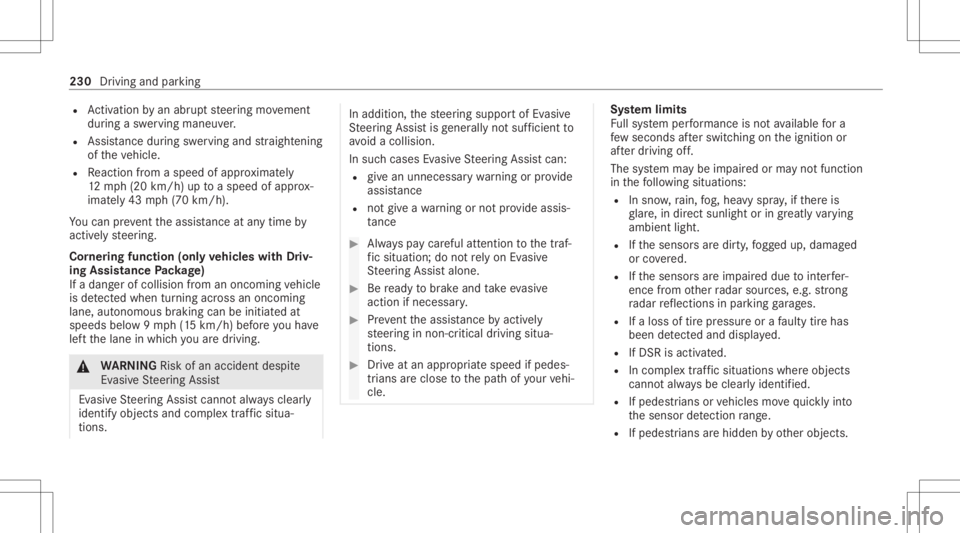
R
Activati on byan abr uptst eer ing movement
dur ing asw erving maneu ver.
R Assi stanc edur ing swervin gand stra ight enin g
of theve hicle.
R React ion from aspee dof appr oximat ely
12 mp h(20 km/h) uptoaspee dof appr ox‐
imat ely43 mph(70 km/h).
Yo ucan preve nttheassis tance atanytime by
act ivel yst eer ing.
Cor nering function (onlyve hicl eswith Driv‐
ing Assistanc ePa ckag e)
If adang erofcoll ision from anoncoming vehicle
is de tected whe ntur ning across anoncomi ng
la ne, autonomo usbraki ng can beinitia tedat
speeds below9mp h(1 5 km/h) beforeyo uha ve
lef tth elane inwhic hyo uar edr ivin g. &
WARNIN GRisk ofan acci dent despite
Ev asive St eer ing Assis t
Ev asiv eSt eer ing Assis tcann otalw aysclear ly
ident ifyobje ctsand complextraf fic situ a‐
tions . In
addition, thesteer ing suppor tof Evasiv e
St eer ing Assis tis ge ner ally no tsu fficien tto
av oid acollision.
In suc hcases Evasiv eSt eer ing Assis tcan:
R givean unnec essarywa rning orprov ide
assis tance
R notgi ve awa rning ornotpr ov ide assis‐
ta nce #
Alw ayspa ycar eful attention tothetra f‐
fi c situ ation; donotre ly on Evasiv e
St eer ing Assis talone. #
Beready tobrak eand take evasiv e
act ion ifnec essar y. #
Preve nttheassis tance byact ivel y
st eer ing innon -critical driving situa‐
tion s. #
Drive at an appr opriatespeed ifpedes‐
tr ians areclose tothepat hof your vehi‐
cle. Sy
stem limit s
Fu llsy stem perform anc eis no tav ailable fora
fe w sec ond saf te rswi tching ontheignition or
af te rdr iving off.
The system maybe impair edorma yno tfunc tion
in thefo llo wing situat ions:
R Insno w,rain, fog, hea vyspr ay,if th er eis
gl ar e, indir ect sunlight oringrea tly varying
ambien tlight .
R Ifth esensor sar edir ty,fo gg ed up, damag ed
or covered.
R Ifth esensor sar eim pair eddue tointerfer‐
ence from other radar sour ces, e.g.stro ng
ra dar reflect ions inpar king garage s.
R Ifaloss oftirepr essur eor afa ulty tirehas
been detected and displ aye d.
R IfDS Ris activ ated.
R Incom plextra ffic situat ionswher eobje cts
can notalw aysbe clear lyident ified.
R Ifpedes trians orvehicles movequickl yint o
th esensor detection rang e.
R Ifpe destrians arehidde nby other objects . 230
Driving andparking